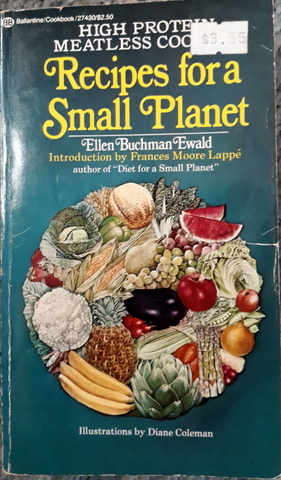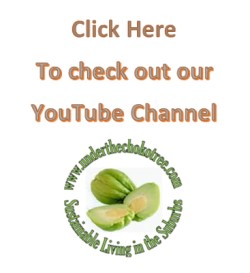Some of these books are recipe books some are about the how and why of cooking ‘greener’ and others are a mix of recipes along with the how and why.
The Green Kitchen – Richard Ehrlich – Kyle Cathie Ltd (UK) 2009 ISBN 978 1 85626 804 2 – This one is a really good book for cooking more sustainably with techniques and recipes for cutting energy use, saving money and reducing waste. The techniques (with accompanying recipes) covered include lidded cooking, microwave cooking, pressure cookers, no-cook cooking and cooking for multiple meals. There are also sections on equipping a green kitchen, greener cleaning and reducing waste. Lots of great information, this is a great little book.
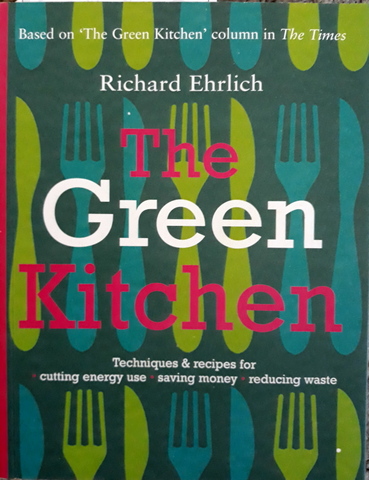
The Green Food Bible – Judith Wills – Transworld publishers (UK) 2008 ISBN 978 1 90581 118 2 – This book reflects the UK experience (obviously) and some of the information about importation of food and statistics around green food production may not translate here, and will be a bit out of date. Section one discusses what the term ‘green’ actually means, and what people think it means. Section two talks about organic food and what that means, its advantages and disadvantages and how to make choices around food. Section three unpacks the broader subject of ethical eating and issues associated with it like local, fair trade, food miles, cheap food, seasonal eating plus other factors and how they interact. Section four talks about ethical shopping such as supermarkets vs small shops, farm shops and markets food labelling and packaging (again all UK-centric), Section five, the green kitchen, covers food storage, prep and cooking, food waste, cleaning up as well as other issues like growing your own and picking your own. Section six covers seasonal menus and recipes, section seven covers eating out and section eight discusses and A to of ‘green’ food. Lots of good info, if some is a bit dated and some colour photos.
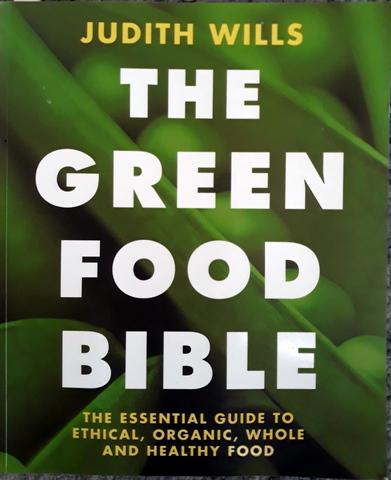
Simple Green Suppers – Susie Middleton – Roost Books (US) 2017 ISBN 978 1 61180 36 5 – This is mostly a recipe book for one-dish vegetarian meals. An introduction talks about the overall strategy of the book, that is to say adopting the idea of eating vegetables plus one other ingredient as a single dish meal. It then covers how to refresh and restock your larder, embrace ‘make aheads’, focussing on one-dish recipes and then how to design your own veggie supper. The rest of the book is devoted to recipes are grouped in chapters that pair up veggies with another specific ingredient. In order the chapters cover veggies plus noodles; plus grains; plus beans; plus leaves; plus toast; plus tortillas; plus eggs; and plus broth. We have found it to be a very helpful book. Lots of colour photos.
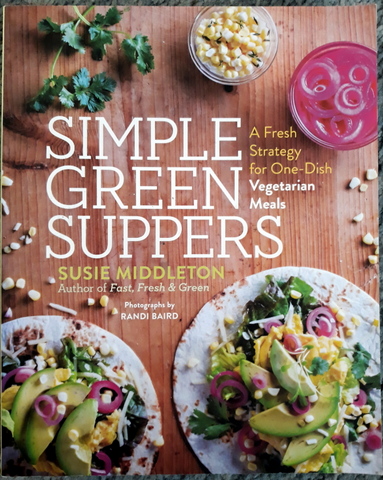
The Organic Kitchen – Lance Reynaud & Duncan Campbell – New Holland Publishers (AUS) 1996 ISBN 978 1 86436 412 2 – Chapter one talks about what organics is and the various certifications that are around, followed by definitions of various terms relating to food and growing an whether they are acceptable for organic use. Chapter two is ‘keeping and organic kitchen’ covering pest control (cockroaches, mice etc), kitchen hygiene, kitchen ecology, cooking equipment (they suggest not having a microwave because it emits radiation eg Xrays, so they do not understand the difference between ionising and non-ionising radiation) and preparation equipment and how to store food. Chapter three is how to eat organically all–year-round and includes charts on seasonality of food in Australia and what foods are available when as well as where processed foods come from (Aus or overseas) Also covered is basic how to preserve fruit and veg. Chapter four covers ‘organic cooking’ including cooking hygiene, common herbs and spices and how to use them, sprouting, soups, sauces and dressings, main courses including meat, veg, fruits and nuts, raw foods, desserts, breakfasts and baby food and baking. Chapter five, ‘the organic cookbook’ is a series of recipes. The book gives a good introduction into a lot of topics, but not a lot of depth in each one. It has the odd black and white photo.
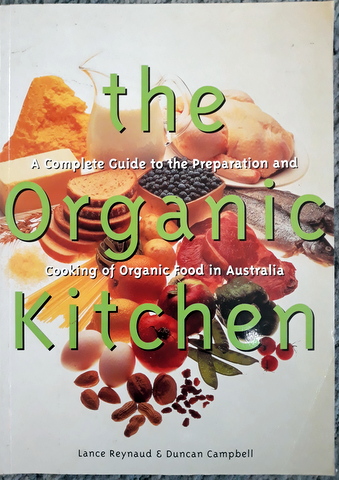
The Conscious Kitchen – Alexandra Zissu – Clarkson Potter Publishers (US) 2010 ISBN 978 0 307 46140 7 – This is not a recipe book, but more a how to buy and cook food, clean up and deal with waste. The introduction talks about essential terms like ’organic’, ‘agribusiness’ and ‘fair trade’ and what they mean. Chapter one covers what sort of food to buy and talks about organics, GM foods, local foods, carbon footprint and local vs organic food. Chapter two covers fruits and veg and where to shop, chapter three covers farm animals, the ethical options and what they mean and where you can get the products, chapter four covers similar for dairy and eggs, chapter five for seafood, chapter six for drinks and chapter seven for packaged foods. Chapter eight focusses on pots pans, food storage and table top, or in other words what you are cooking in and on, avoiding plastics and setting you table safely and sustainably. Chapter nine covers appliance and low energy cooking which focusses on the best appliances to get and getting the best out of your appliances (including microwaves!). Chapter ten covers safe and sustainable clean up and chapter eleven covers dealing with waste in the kitchen. It is a small book with lots of information. No photos.
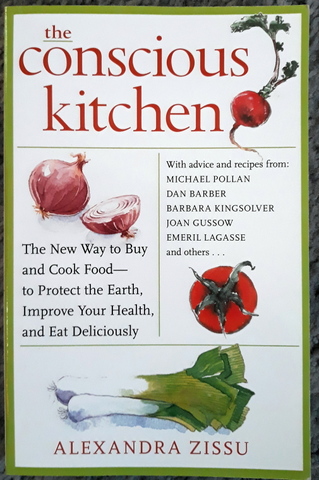
The Kitchen Handbook (an Environmental Guide) – Teri Degler& Pollution Probe – McClelland & Stewart Inc. (CAN) 1992 ISBN 978 0 7710 7144 2 – This is an oldie but a goodie, mostly a ‘what and why’ book, but with some recipes at the end. Chapter one covers setting up your green kitchen including making the most of space, setting up for recycling, composting, tips on appliances and what you need, water, lighting and cookware. Chapter two covers stocking your shelves with environmentally friendly goods, when fruit & veg are in season (in Canada), labelling, is it greenspeak or really green, livestock and fish issues, a few recipes. Chapter three is about using the green kitchen including what cooks quicker, getting the most out of your appliances, plastics and food safety, protein form plants, growing edible plants inside and using leftovers. Chapter four covers storing and preserving foods to avoid waste, Chapter five covers eco cleaning and pest control, and chapter six provides a series of recipes (19 all up) for the green kitchen. Chapter seven (the kitchen audit) provides information for you to review your existing kitchen and work out how you can implement the improvements in each chapter of the book, which is a wonderful idea! The book has lots of line drawings.
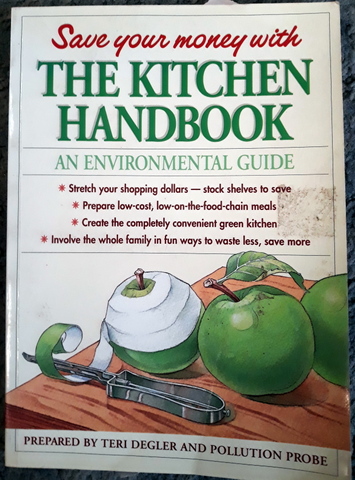
The Conscious Cook – Giselle Wilkinson – Brolga Publishing P/L (AUS) 2008 ISBN 978 1 921221 38 5 – The first half of the book is composed of fifty one recipes broken down into sections: Party (9); Soups (6); Mains (22) and Desserts (14). The second half is divided into a number of parts and chapters. Part one is titled ‘how what you eat affects you’, and focusses on health and nutrition, food issues like food additives and GM foods, organics and wholefoods. Part two is titled ‘how what you eat affects you’ and is focussed on sustainability, fair trade, local eating and waste. Part three is titled ‘what you can do about it’ and focusses on personal actions around sustainability and diet, cooking, local food, shopping and what food to buy, Australian made, globalised food supply and green cleaning. Last of all is a ‘conclusion’ that summarises what needs to be done and why the book was written. The book has lots of colour photos.
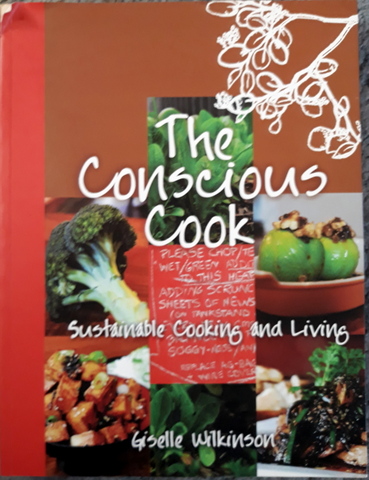
Ethical Eating – Angela Crocombe – Penguin Books (AUS) 2008 ISBN 978 0 1 300856 9 – Chapter one discusses the issues associated with ethical eating including climate change, water use, overfishing, animal welfare, erosion and salinity, chemical use, toxins in food, packaging and economic ‘externalities’. Chapter two discusses organic and biodynamic farming, what they are, how they work, are certified etc. Chapter three discusses fruit and vegetables including seasonal produce, chemicals, hydroponics and native foods. Chapter four covers issues associated with chicken and egg production including organic and free range. Chapter five covers meat and the issues associated with its production including feedlots and native animals for meat. Chapter six covers issues associated with dairy production and chapter seven seafood including overfishing and aquaculture. Chapter eight discusses drinks including soft drinks, alcoholic drinks and hot drinks. Chapter nine discusses vegetarianism, Chapter ten ethical eating movements live slow food and fair trade, chapter eleven discusses GM foods. Chapter 12 discusses processed foods, marketing and irradiation, chapter 13 food shopping and chapter 14 is a conclusion with a page and a half of suggestions for ethical eating. Every chapter has a summary of one page at the end called ‘In a Nutshell’. There are no photos or line drawings in this book.
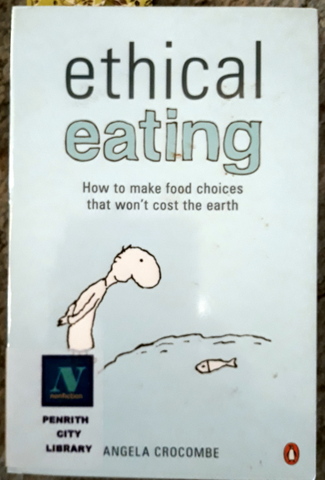
You can have your Permaculture and Eat It too – Robin Clayfield (self-published in AUS) 2013 ISBN 978 0 99230 181 1 – is this a cookbook for gardeners or a gardening book for cooks? This book is sort of divided into two parts, the first third of the book talks about permaculture principles and ethics, zone one and two, being hands on in the garden, pest control and making an income from your garden and takes up the first 80 pages. The remainder of the book covers stuff that you rarely see about cooking for a small or large group of people using mostly vegetarian and some out of the ordinary ingredients. The first section covers useful cooking tools, cooking in bulk, special needs and diets, as well as food prep. The second part provides a whole stack of recipes under such subjects as recipes for 4 or 40, healthy eating and food combining, permaculture foods including bush tucker and weeds. Also included is a section on the edible flower garden, cosmetics from the garden and ‘tit bits’ like bottling, cheesemaking, butter, tofu, miso and tempeh, TVP seaweed and food storage. The last section covers after dinner fun and games. This hugely useful book is worthwhile having on everyone’s library shelves. There are some line drawings.
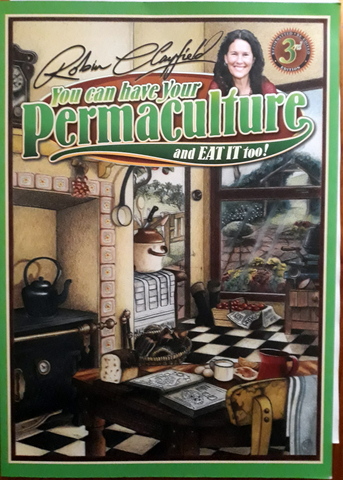
Diet for a Small Planet – France Moore Lappé – Ballantyne Books (US) 1975 ISBN 0 345 27429 6 – This is my copy, it has probably been updated many times since then. This small paperback is over 400 pages long and is very information dense, dealing with the accessing of protein without resorting to meat. While it does have some recipes, it is not primarily a recipe book, but is more about the ‘why’ and the ‘how’ of meat free protein. The book is written in four parts. Part one is about current protein sources and the issues with their exploitation, Part two is bringing protein theory down to earth, covering issues like how much is enough, is meat necessary and protein complementing. Part three is Eating from the earth: where to get protein without meat, which discusses protein sources, how they the food groups rate protein wise, getting the most protein for the least calories and your protein dollar. Part four covers Eating form the earth: how to get protein without meat, talking about protein combing, kitchen short cuts, what to have on hand and shopping. The book has a small number of line drawings.
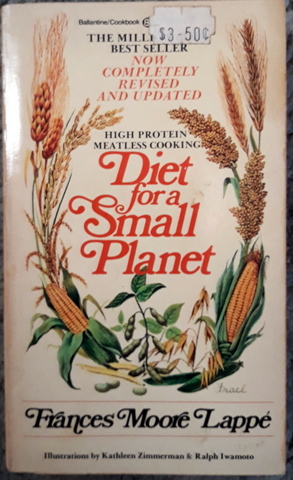
Recipes for a Small Planet – Ellen Buchman Ewald - Ballantyne Books (US) 1973 ISBN 0 345 27230 X – This is the recipe book associated with ‘Diet for a Small Planet’. There are two non-recipe sections at the front: Protein complementarity and Living with the earth in mind. The book then moves on for the next 300 or so pages on applicable recipes broken down into sections entitled ‘What’s for breakfast’, ‘What’s for lunch’, a subsection on one pot meals and another on raw foods, ‘What’s for Dinner. This is followed by two sections on bread, one on cookies and bars (sweets), ‘just desserts’, and ‘dairy delights’ and a series of appendices on basic cooking, useful utensils etc. It is a gread companion volume to help put the ideas espoused in ‘Diet for a Small Planet’ into action in your life. The book also has a small number of line drawings.
